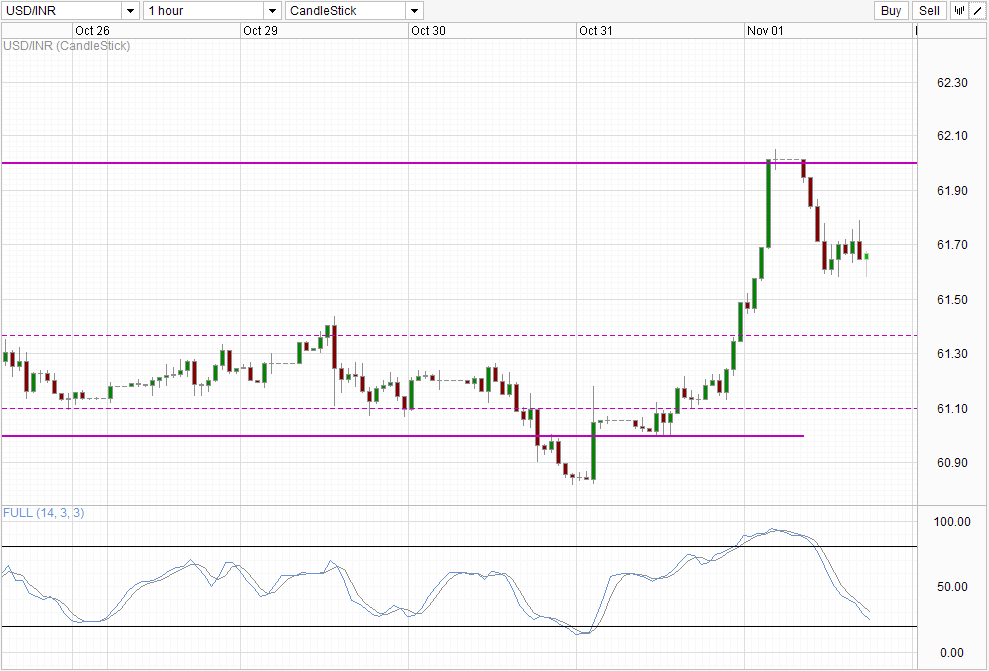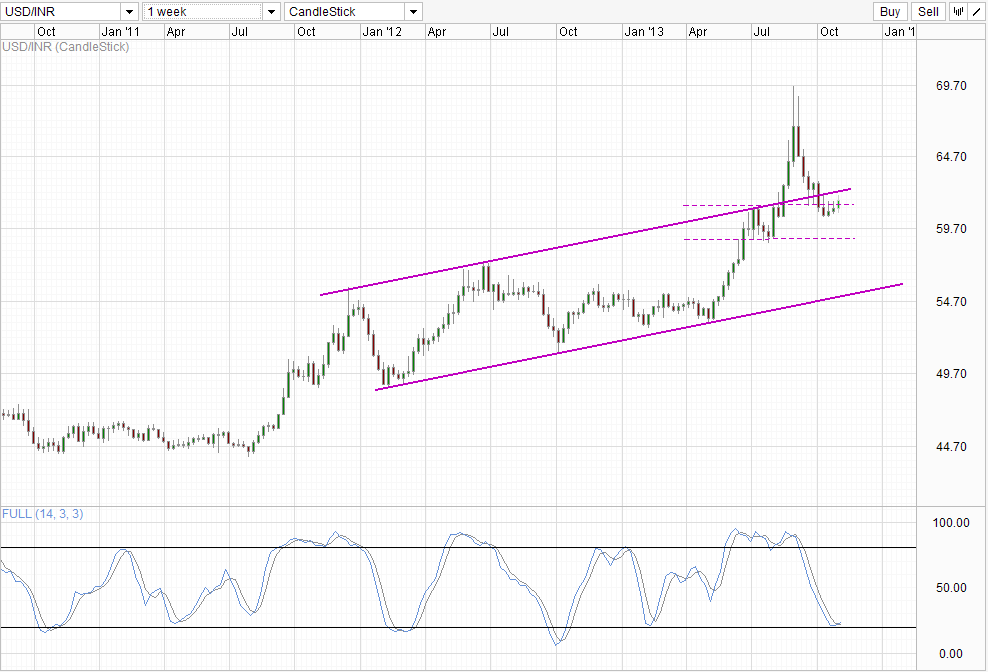Rupee weakened against the Greenback yesterday following the strengthening of USD yesterday – a move fueled by speculation that a December QE tapering event will happen. However, market did not share the same bullishness today, with bears pressing down immediately when Indian market opened today. Prices fell to a low of 61.6 before bulls mounted a proper response, with price currently trading within a consolidation range from 61.6 – 61.7.
Considering that USD/INR has been trading sideways and under heavily influence by technicals recently, the decline could be sparked by technical bears betting that USD/INR will not be able to breach the 62.0 round figure resistance, which happens to be the floor in late September and the ceiling back on 9th – 10th October. Stochastic readings hitting Overbought en route to 62.0 helped build bearish conviction, and encouraged even heavier selling of USD/INR during early Asian trade.
Hourly Chart
This rejection from 62.0 should open up a move towards 61.4, but that is looking less likely with Stochastic readings currently close to Oversold territories. It is likely that a retest of 61.5 would push Stochastic below 20.0, favoring a retest of 61.7 from here instead. The best bears can hope for is for prices to continue staying around 61.7, which will allow bearish momentum to take a well deserved break before a fresh new bearish cycle stoch signal emerge in conjunction with price pushing below 61.6.
On a separate note, it was observed previously that USD/INR bears were having a slight edge over bulls, and this behavior remains even though prices have rallied yesterday. Latest Manufacturing PMI for the month of October showed that economic activity has contracted for a third straight month, but bullish reaction in USD/INR remain muted, and suggest that bears remain in the driving seat albeit marginally, but nonetheless improving the odds of a move back towards 61.4 eventually.
Weekly Chart
Weekly Chart is less bearish than before though, as the break of 61.4 effectively means that price has broken away from the 59.0 – 61.4 consolidation back in July, which opens up the possibility of a retest of Channel Top. Stochastic readings have also just crossed the Signal line, giving us a bullish cycle signal that may still be valid as there are precedent for troughs happening around the same levels. Nonetheless, immediate bias remains lower as long as prices stay within the Channel, with Channel Bottom remaining a viable bearish target.
That being said, it should be noted that India’s economy continue to look precarious. The latest PMI data reflected the highest input cost growth since June 2012, while output costs have also rose at the fastest pace since Feb 2013. This shows that inflation is still raging high even though RBI has raised interest rate last month. If the recent rate hike does not stop the rise in inflation, Governor Rajan may be forced to utilize other methods as the past 2 rounds of rate hike would have ended hurting the economy without achieving anything good. Failure to address this issue will definitely not go down well with the markets, and a return of May – September rally in USD/INR will be likely, sending USD/INR into fresh highs in 2013 if not early 2014.
More Links:
GBP/USD – Finds Support at 1.60
AUD/USD – Continues to Drift Lower below 0.95
EUR/USD – Drops Sharply to Two Week Low below 1.36
This article is for general information purposes only. It is not investment advice or a solution to buy or sell securities. Opinions are the authors; not necessarily that of OANDA Corporation or any of its affiliates, subsidiaries, officers or directors. Leveraged trading is high risk and not suitable for all. You could lose all of your deposited funds.




